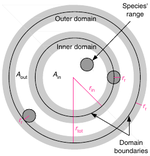Abstract
Predictions of how different facets of biodiversity decline with habitat loss are broadly needed, yet challenging.
Here we provide theory and a global empirical evaluation to address this challenge. We show that extinction estimates based on endemics–area and backward species–area relationships are complementary, and the crucial difference comprises the geometry of area loss. Across three taxa on four continents, the relative loss of species, and of phylogenetic and functional diversity, is highest when habitable area disappears inward from the edge of a region, lower when it disappears from the centre outwards, and lowest when area is lost at random. In inward destruction, species loss is almost proportional to area loss, although the decline in phylogenetic and functional diversity is less severe. T
hese trends are explained by the geometry of species ranges and the shape of phylogenetic and functional trees, which may allow baseline predictions of biodiversity decline for underexplored taxa.
